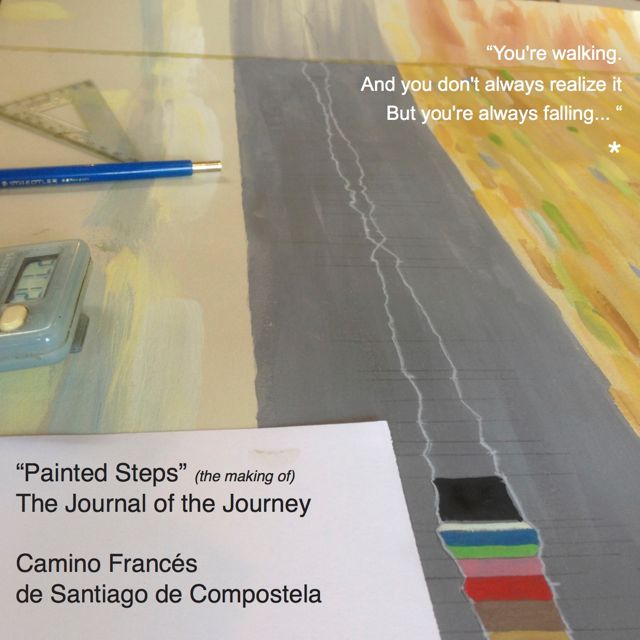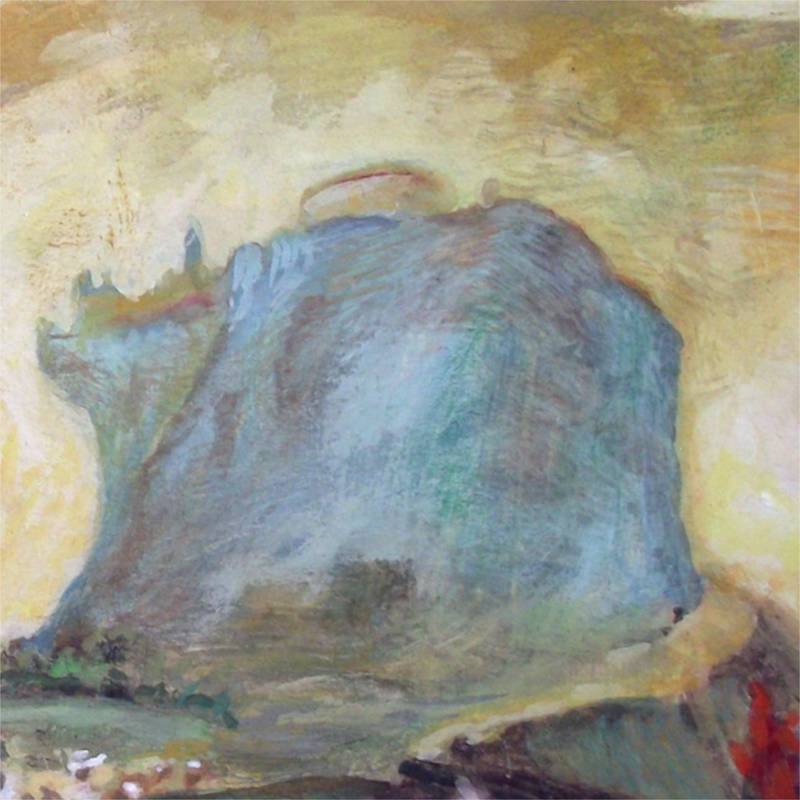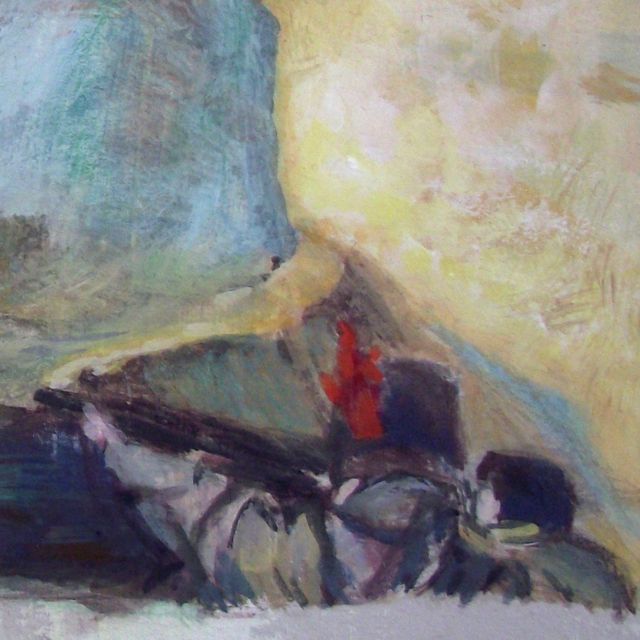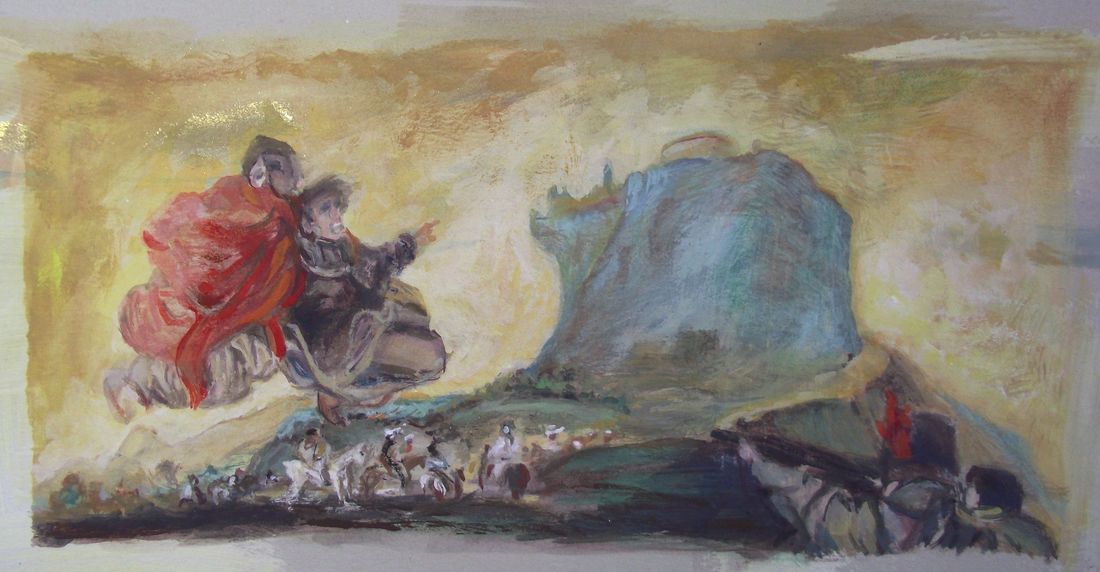|
Failure is a useful benchmark. In my copy of Visíon Fantástica I am pleased with the beauty of the colour but I was not able to capture the ethereal quality of Goya’s mountain. This failure points out how subtle differences can affect the reading of a painting. In Goya’s Visíon, the mountain is a metaphor of hopefulness, more poignant. The man points, but it is pointless… It is said that this mountain or butte refers to Gibraltar. Gibraltar; aka ‘The Rock’, the gateway into the Mediterranean, the threshold out, the Pillars of Hercules, the stepping stone between Europe and Africa. It marks a direction of possible escape off the Iberian Peninsula into Africa for those fleeing anti Semitism (a major ‘pogrom’ in 1350) as well as the 1492 expulsion of Muslim Iberians. The Umayyad Caliphate gave it its present name from the Arabic, Jebel Tariq. I get a picture of the ‘multi-culturalism’ of the peninsula as a whole in this reference to Goya’s town Zaragoza, which according to Enrique Cock, a 16th century Dutch Catholic historian exiled to Spain, was at one point inhabited fully by Moriscos. He wrote, "(They) would rather go on a pilgrimage to Mecca than Santiago de Compostela" http://www.proyectos.cchs.csic.es/humanismoyhumanistas/enrique-cock There is a ‘classical ’ Olympian look to the city on the Mountain. Perhaps the city is an incarnation of the classical ideal, a pinnacle of rational living, peace, and beauty. Perhaps this is the “reason” referred to by Goya’s title for his etching “The Sleep of Reason Produces Monsters” (El sueño de la razón produce monstruos)(1798). A third element in Visíon Fantástica is the long line of people on the move coming from as far as the eye can see. It’s the typical trail of fleeing populations, a straggle of men and women, on foot, on horseback, carrying bundles of all kinds. The armed horsemen at the head of the line seem unsure of which direction to take. At the center foreground is the crossroads. Will they lead the way up the mountain road? The right hand corner of the painting holds the fourth element that seems at first to exist in it’s own scale, in it’s own system of perspective. But then you notice how it intersects and interacts with the other elements. A shock! Two soldiers, are tucked in the bottom corner of the painting, hidden from the road, sharpshooters, ready to pick off passers by. Their silhouette, with the distinctive cockade-ed cap is familiar from paintings, prints, movies, etc. - French soldiers circa Napoleon, identified by their ‘significant profile’ like one identifies a type of bird. Each member a no-name, called only by their species. The soldiers, like the flying couple, are in close-up but with their backs to us. You can’t see their faces, you don’t relate to them personally or empathize with their individual lot. Who are these soldiers, these men? Why are they here less than 20 years after the French Terror, after liberty-equality-fraternity, after the poverty of a France stripped to provide luxury, for the ‘1%’. These men are the massive boot of Napoleon in the thirsty drive for empire. They walked across France, Spain, Portugal. They walked to Moscow. That was their Camino. The painting Visíon Fantástica o Asmodia is a worldview with multiple systems of perspective and scale in a cohesive ‘natural’ landscape. It is an insistence that the world is all happening at the same time –now- believe it or not. While walking the Camino it could be easy to feel like you’re living in a 2-d world with only one perspective - me! You’re living in a very local Here and Now: immediate concerns, immediate delights: my feet, my stomach, the folks, the food, the scenery. The yellow arrows show you your way, the pilgrim menus are set out for you, your bed awaits, along with the friendly greetings of the ‘hospitaleros’ who have spent their day cleaning up after you and preparing for you. Prompted by the ubiquitous coquilles Saint-Jacques, Scallop shell motifs you assume a simple identity: The Pilgrim. You look at the path in front of you and look at the path behind you. The Camino is a line! And yet, The Camino was and continues to be created over time: thousands of people walking in a long line following in each others' footsteps, separated in and distinguished by Time. A thousand years of Time. Each day, there are the ones who went before me (some probably woke me up!) and the ones who come behind me, following in my footsteps, different times, different perspectives. With the dimension of Time, the line unfolds into a 3-dimensional world. Painted Steps will be seen one day, all at once. All in good time! "Stay calm, wait for the sign", Buen Camino! addendum
------------------------------------------------------------- Dimensional thinking: Flatland: A Romance of Many Dimensions is a satirical novella by the English schoolmaster Edwin Abbott Abbott, first published in 1884 by Seeley & Co. of London. To The Inhabitants of SPACE IN GENERAL And H. C. IN PARTICULAR This Work is Dedicated By a Humble Native of Flatland In the Hope that Even as he was Initiated into the Mysteries Of THREE Dimensions Having been previously conversant With ONLY TWO So the Citizens of that Celestial Region May aspire yet higher and higher To the Secrets of FOUR FIVE OR EVEN SIX Dimensions Thereby contributing To the Enlargement of THE IMAGINATION And the possible Development Of that most rare and excellent Gift of MODESTY Among the Superior Races Of SOLID HUMANITY
0 Comments
Leave a Reply. |










 RSS Feed
RSS Feed